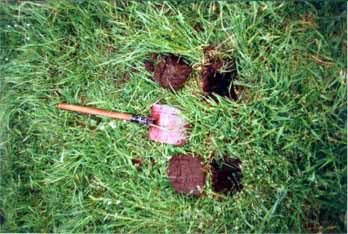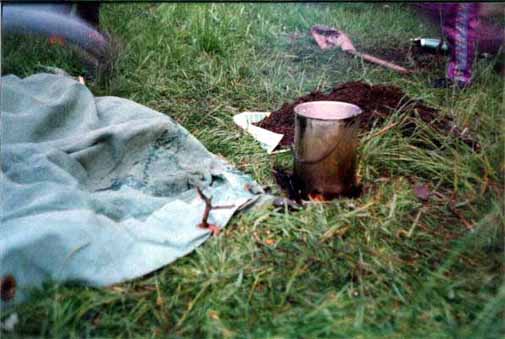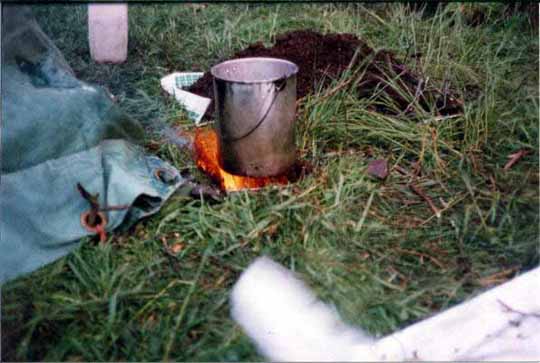THE INDIAN FIRE
The first question to answer is what is an Indian Fire?
Well the answer is that it is the only fire which performs best
in high wind. Curiously the Indian fire is hardly mentioned in any Scout
publication and so this web page will try to put it right!
The Indian fire is unusual among fires because it's flame can be
changed from a smouldering bed of embers to a raging blast furnace in a
few seconds. The Indian fire has several distinct advantages over normal
fires: it is virtually smokeless; very fuel efficient; fully controllable;
easy to clear up after use and works well in high winds. In fact the Indian
fire not only works well in wind, it requires a wind to operate. This gives
it its biggest advantage over normal fires.
Building an Indian fire is easy.  Firstly
find a piece of ground with good, dry-ish soil (sandy soils are easier
to dig but tend to collapse onto the fire), note the wind direction and
dig two holes in line with the wind direction The holes should be of a
diameter slightly less than the pot you are going to use and about two
pot widths apart. The holes should be about nine inches to a foot deep.
Firstly
find a piece of ground with good, dry-ish soil (sandy soils are easier
to dig but tend to collapse onto the fire), note the wind direction and
dig two holes in line with the wind direction The holes should be of a
diameter slightly less than the pot you are going to use and about two
pot widths apart. The holes should be about nine inches to a foot deep.
Once you have dug the two holes, dig along between the bottom of
the two holes, joining them up to form a rough U shaped tunnel. Build a
pot support at the mouth of the downwind hole (the exhaust hole), this
can be anything from three similar sized stones place at equal distances
around the mouth to a hanging pot holder. 

The choice is yours, however you must leave a gap between the mouth
of the hole and the pot base to allow for good air circulation and to feed
fuel down.
Next you must build a windbreak between the two holes, the simplest
windbreak is a flat piece of wood angled down towards the upwind hole (the
intake hole).
Your windbreak should be able to be moved from an upright position
to lie flat over the intake (the low flame position).

With the windbreak in the low flame position (ie either laid over the
intake hole or removed altogether ), light your fire in the base of the
exhaust hole. As the fire catches slowly lift the windbreak from the hole
until it is at approximately 45° (the maximum flame position). The
fire should burn strongly now. In high winds with a windbreak at maximum
flame, it is possible to burn up your wood supply very quickly so be sure
to have a good supply of wood cut to size. As you cook with the fire the
wind will rise and fall and so will the flame. It will be necessary to
adjust the windbreak from time to time to obtain the required flame. In
high winds you will have to reduce the flame to prevent the food (or the
pot) from burning. Just to give you an idea of how strong the flame can
be in wind, I have seen a jet of flame, three to four feet high, produced
from a fire with a hole diameter of just six inches!
 The principle of the Indian fire is similar to that of the Jet engine.
Air is forced into the intake to the jet / fire where it is directed to
the combustion chamber. In the combustion chamber the air and fuel / wood
are mixed and ignited, the resulting flame is blown out through the exhaust
port. The more air which is introduced to the fire, the faster and more
complete the combustion. This makes the fire very fuel efficient. In fact
after using the fire in a good wind there will be some gray ash in the
bottom of the hole instead of the charcoal sticks and half burned wood
normally found in traditional fires. Another property of the fire which
makes it very efficient is that all the heat is directed upwards, very
little escapes into the soil since the soil acts as an heat insulator.
Conventional fires lose heat in all directions - out to the sides, diagonally
out as well as up into the pot.
The principle of the Indian fire is similar to that of the Jet engine.
Air is forced into the intake to the jet / fire where it is directed to
the combustion chamber. In the combustion chamber the air and fuel / wood
are mixed and ignited, the resulting flame is blown out through the exhaust
port. The more air which is introduced to the fire, the faster and more
complete the combustion. This makes the fire very fuel efficient. In fact
after using the fire in a good wind there will be some gray ash in the
bottom of the hole instead of the charcoal sticks and half burned wood
normally found in traditional fires. Another property of the fire which
makes it very efficient is that all the heat is directed upwards, very
little escapes into the soil since the soil acts as an heat insulator.
Conventional fires lose heat in all directions - out to the sides, diagonally
out as well as up into the pot.
As with normal fires, the type of wood used in the fire will yield
different results. Small twigs will flare up and produce a hot high flame
and large logs will produce a long slow flame. Using large logs in the
Indian fire is not practical due to the narrow width of the hole however
a slow cool flame can be produced if the hole is stacked with short (hole
width or slightly shorter) logs and the windbreak lowered to almost flat.
For a hot, fast cooking flame, short twigs of about a finger's width in
diameter should be dropped down the exhaust hole from time to time and
the windbreak opened to about 45°.
The windbreak is the most important element of the Indian fire, not
only does it collect and force the air down into the fire, it also acts
as a windbreak, preventing the wind from blowing the flames around. The
simple windbreak of a flat piece of wood, metal etc in not very efficient
since a lot of the air will escape from the sides of the windbreak. The
ideal windbreak should have fully enclosed sides and be angled down towards
the hole. If you wish to experiment with windbreaks try a square of heavy
canvas pegged with one corner at the hole, two other corners should be
pegged out at equal distances from the hole. A bit of wood can be used
to prop up the remaining corner. This will form a triangular air scoop
which should ram the air very efficiently into the fire. Reducing the flame
is a simple matter of moving the side pegs further out, lowering the front
of the scoop or covering the entrance hole a little. The flame can be increased
by moving the pegs in until they make an angle of around 45° with the
hole. At this point the windbreak should scoop the maximum amount of air.

The Indian fire is easier and less messy to tidy away than conventional
fires. Simply put the fire out by pouring water down the hole, fill in
the soil and replace the two pieces of turf. No need to dig a hole to bury
the ashes, the hole is already dug and no large rolls of turf to replace,
only two small squares.
The Indian fire provides a great deal of scope for experimentation
and as such can provide a worthwhile activity for a Scout night or camp.
The windbreak: what is the best shape and material to make it from; is
it possible to make an easily moveable windbreak instead of messing about
with pegs and wooden props? The fire itself: does the intake hole have
to be vertical, would an angled hole produce a better air flow; would an
intake hole larger than the exhaust hole produce a hotter flame (enlarging
the exhaust hole is not a good idea since instead of striking the bottom
of the pot, the flame will lick up around the outside and, apart from being
wasteful of heat, can either heat up the handle to a dangerous level or
else melt it off! Iím not joking!); does the fire have to sit on the bottom
of the hole; will the addition of a small metal grille which raises the
fire up a little allow the air to reach all the fire from below and so
work better? Why not try the Indian fire on a troop night and give the
Patrols the chance to experiment with improving the fire.
 Firstly
find a piece of ground with good, dry-ish soil (sandy soils are easier
to dig but tend to collapse onto the fire), note the wind direction and
dig two holes in line with the wind direction The holes should be of a
diameter slightly less than the pot you are going to use and about two
pot widths apart. The holes should be about nine inches to a foot deep.
Firstly
find a piece of ground with good, dry-ish soil (sandy soils are easier
to dig but tend to collapse onto the fire), note the wind direction and
dig two holes in line with the wind direction The holes should be of a
diameter slightly less than the pot you are going to use and about two
pot widths apart. The holes should be about nine inches to a foot deep.




